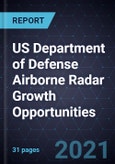The Defense Industry is Working with Government Agencies to Improve Range, Discrimination, and Collaborative Targeting
This research service focuses only on US Department of Defense (DoD) airborne radars; space, maritime, and ground radars are not included. Representative programs, contracts, and market participants are included to form an overview picture of DoD spending on this technology. An analysis of research, development, test, and evaluation (RDT&E); procurement; operations and maintenance (O&M); and a variety of services is included, along with contract activity for the 2021 fiscal year. Spending consists of Army, Navy/Marine Corps, Air Force/Space Force, and Joint Service plans. The base year for financial spending is 2020, and the market forecast is from 2021 to 2026. Airborne radar spending for the fiscal year 2022 DoD budget request is the foundation of this research. The 2022 DoD request is the first budget submission by the Biden administration, and may encounter opposition from both sides of the political aisle. The new research outlines the defense departments, agencies, and industry partners that offer the best opportunities for companies that want to participate in the market.
The research includes market trends and future concepts that shed light on some spending numbers and the importance of participating in certain projects and programs. It assists in understanding the government’s focus and the services it will likely require. Insights are provided on current and anticipated program spending and industry leaders, which will help firms identify growth opportunities and formulate go-to-market strategies.
Research methodology:
The publisher’s research services are based on secondary and primary research data. Information has been garnered from existing reports and project material in their database, including technical papers, specialized magazines, seminars, and government program and contract data. Senior consultants/industry analysts conduct interviews have over the phone with component providers, original equipment suppliers, lead system integrators, government acquisition officials, and end users. Primary research accounted for approximately 25% of the research.
Table of Contents
1. Strategic Imperatives
Why is it Increasingly Difficult to Grow?
The Strategic Imperative 8™
The Impact of the Top Three Strategic Imperatives on the US DoD Airborne Radar Industry
Growth Opportunities Fuel the Growth Pipeline Engine™
2. Growth Opportunity Analysis
Purpose and Overview
Trends and Challenges
Market Segmentation
Technology Applications
Growth Drivers and Restraints
Program Funding by Department
Program Funding by Type
Representative Programs
Representative Industry Participants
Top 10 Contracts
3. Growth Opportunity Universe
Growth Opportunity 1: Air Force Radars
Growth Opportunity 2: Army Radars
Growth Opportunity 3: Joint Service Radars
Growth Opportunity 4: Navy/Marine Corps Radars
Conclusions and Future Outlook
List of Exhibits
Legal Disclaimer








